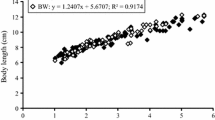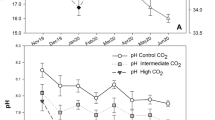Abstract
A 50-day experiment was conducted to investigate the effects of constant Ca2+ concentration in salinity fluctuations on growth and energy budget of juvenile Litopenaeus vannamei. The salinity and Ca2+ concentration of control group S0 were kept 30‰ and 385 mg l−1, respectively throughout the experiment while the ranges of salinity fluctuations of the treatment groups S5 and S5C, S10 and S10C, S15 and S15C, S20 and S20C were 5, 10, 15, and 20‰, respectively. The Ca2+ concentration of the treatment groups S5, S10, S15, and S20 (salinity fluctuation groups) changed with salinities, while the Ca2+ concentration of the treatment groups S5C, S10C, S15C, and S20C (constant Ca2+ concentration groups) was kept 385 mg l−1 during the experiment. The results were as follows: (1) There were no significant differences in SGR of shrimp in salinity fluctuation groups (P > 0.05); But shrimp in the groups S15C and S20C had significantly higher SGR than those in the groups S5C and S0 in constant Ca2+ concentration groups (P < 0.05); (2) Results of the t test showed that significant differences in SGR were also found between S15 and S15C (P = 0.012), and between S20 and S20C (P = 0.013); (3) The shrimp in groups S15C and S20C deposited significantly more energy for growth and spent significantly less energy in respiration than those in groups S15 and S20 (P < 0.05), respectively. These results showed that compared with constant salinity and fluctuating salinities, the growth performance of shrimp under constant Ca2+ concentration in large ranges of salinity fluctuations could be better.





Similar content being viewed by others
References
Bray WA, Lawrence AL, Leung-Trujillo JR (1994) The effect of salinity on growth and survival of Penaeus vannamei, with observations on the interaction of IHHN virus and salinity. Aquaculture 122:133–146
Carlos R, Nelda L, Pedro M, Evenor M (2001) Effect of salinity acclimation on oxygen consumption of juveniles of the white shrimp Litopenaeus vannamei. J Crustac Biol 21:912–922
Castille FL, Lawrence AL Jr (1981) A comparison of the osmotic sodium and chloride concentrations between the urine and hemolymph of Penaeus setiferus (L.) and Penaeus stylirostris Stimpson. Comp Biochem Physiol 701:525–528
Crocker PA, Arnold CR, DeBoer JA, Holt GJ (1983) Blood osmolality shift in juvenile red drum Sciaenops ocellatus L. exposed to fresh water. J Fish Biol 23:315–319
Dall W (1981) Osmoregulatory ability and juvenile habitat preference in some penaeid prawns. J Exp Mar Biol Ecol 54:55–64
Ding S, Wang F, Guo B, Li XS (2008) Effects of salinity fluctuation of the molt, growth, and energy budget of juvenile Fenneropenaeus chinensis. Chin J Appl Ecol 19:419–423 (in Chinese, with English abstract)
Do Thi TH, Tobias W, Mark B, NguyenThanh P (2010) Osmoregulation, growth and moulting cycles of the giant freshwater prawn (Macrobrachium rosenbergii) at different salinities. Aquacult Res 41:1–9
Dong SL, Du NS, Lai W (1994) Effects of PH and Ca2+ concentration on growth and energy budget of Macrobrachium nipponense. J Fish Chin 18:118–123 (in Chinese, with English abstract)
Feng CM, Tian XL, Dong SL, Su YP, Wang F, Ma S (2008) Effects of frequency and amplitude of salinity fluctuation on the growth and energy budget of juvenile Litopenaeus vannamei. Aquacult Res 39:1639–1646
Ferraris RP, Parado-Estepa FD, Ladja JM, de Jesus EG (1986) Effect of salinity on the osmotic, chloride, total protein and calcium concentrations in the hemolymph of the prawn Penaeus monodon (Fabricius). Comp Biochem Physiol 83:701–708
Grizzle JM, Mauldin AC II, Yong Dennis, Henderson E (1985) Survival of juvenile striped bass (Morone saxatilis) and Morone hybrid bass (Morone chrysops × Morone saxatilis) increased by addition of calcium to soft water. Aquaculture 46:167–171
Konstantinov AS, Martynova VV (1993) Effect of salinity fluctuations on energetics of juvenile fish. J Ichthyol 33:1–8
Kumlu M, Eroldogan OT, Aktas M (2000) Effect of temperature and salinity on larval growth, survival and development of Penaeus semisulcatus. Aquaculture 188:167–173
Lall SP (1989) The minerals. In: Halver JE (ed) Fish nutrition, 2nd edn. Academic Press, San Diego, p 23
Lemos D, Phan VN (2001) Energy partitioning into growth, respiration, excretion and exuvia during larval development of the shrimp Farfantepenaeus paulensis. Aquaculture 199:131–143
Levine DM, Sulkin SD (1979) Partitioning and utilization of energy during the larval development of the xanthid crab, Rithropanopeus harrisii (Gould). J Exp Mar Biol Ecol 40:247–257
Lovell RT (1989) Nutrition and feeding of fish. Van Nostrand Reinhold, New York
Meade EM, Doeller JE, Kraus DW, Watts SA (2002) Effects of temperature and salinity on weight gain, oxygen consumption rate, and growth efficiency in juvenile red-claw crayfish Cherax quadricarinatus. J World Aquac Soc 33:188–198
Mu YC, Wang F, Dong SL, Dong SS, Zhu CB (2005) The effects of salinity fluctuation in different ranges on the intermolt period and growth of juvenile Fenneropenaeus chinensis. Acta Oceanol Sinica 24:141–147
Oduleye SO (1976) The effects of hypophysectomy, prolactin therapy and environmental calcium on freshwater survival and salinity tolerance in the brown trout, Salmo trutta L. J Fish Biol 9:463–470
Panikkar NK (1968) Osmotic behavior of shrimps and prawns in relation to their biology and culture. FAO Fish Rep 57:527–538
Parado-Estepa FD, Ladja JM, de Jesus EG, Ferraris RP (1989) Effect of salinity on hemolymph calcium concentration during the molt cycle of the prawn Penaeus monodon. Mar Biol 102:189–193
Paul AJ, Akira F (1989) Bioenergetics of the Alaskan Crab Chionoecetes bairdi (Decapoda: majidae). J Crustac Biol 9:25–36
Peter G (1983) Uptake of calcium at the postmolt stage by the marine crabs Callinectes sapidus and Carcinus maenas. Comp Biochem Physiol 75:181–184
Peter G (1985) Calcium balance and moulting in the crustacea. Biol Rev 60:425–454
Petrusewicz K, Macfadyen A (1970) Productivity of terrestrial animals: principles and methods (IBP Handbook no. 13). Blackwell, Oxford, p 199
Robertson JD (1960) Osmotic and ionic regulation. In: Waterman TH (ed) Crustacean physiology. Academic Press, New York, pp 317–339
Rosas C, Martinez E, Gaxiola G, Brito R, Sanchez A, Soto LA (1999) The effect of dissolved oxygen salinity on oxygen consumption, ammonia excretion and osmotic pressure of Penaeus setiferus (Linnaeus) juveniles. J Exp Mar Biol Ecol 234:41–57
Saoud IP, Davis DA, Rouse DB (2003) Suitability studies of inland well waters for Litopenaeus vannamei culture. Aquaculture 217:373–383
Spaargaren DH (1975) Energy relations in the ion regulation in three crustacean species. Comp Biochem Physiol 51A:543–548
Staples DJ, Heales DS (1991) Temperature and salinity optima for growth and survival of juvenile prawn Penaeus merguiensis. J Exp Mar Biol Ecol 154:251–274
Stroganov NS (1962) Ekologicheskaya fiziologiya ryb (Ecological physiology of fish). Moscow State University, Moscow
Sutcliffe DW, Carrik TR (1975) Respiration in relation to ion uptake in the crayfish Austropotamobius pallipes (Lereboullet). J Exp Biol 63:689–699
Villarreal H (1994) Effect of temperature and salinity on the oxygen consumption of laboratory produced Penaeus vannamei postlarvae. Comp Biochem Physiol 106:331–336
William WA, Robert RS (1989) Responses of red drum (Sciaenops ocellatus) to calcium and magnesium concentrations in fresh and salt water. Aquaculture 76:21–35
Zoula PZ-E, David VA (1965) Growth and survival of postlarval Penaeus aztecus under controlled conditions of temperature and salinity. Biol Bull 129:199–216
Acknowledgments
This work was supported by the National Nature Science Foundation of China (Grant No. 30571441), Key Project of Scientific and Technical Supporting Programs funded by Ministry of Science and Technology of China (Grant No. 2011BAD13B03) and the Project under the Major State Basic Research of China (Grant No.2009CB118706).
Author information
Authors and Affiliations
Corresponding author
Rights and permissions
About this article
Cite this article
Hou, C., Wang, F., Dong, S. et al. Effects of constant Ca2+ concentration in salinity fluctuations on growth and energy budget of juvenile Litopenaeus vannamei . Aquacult Int 20, 177–188 (2012). https://doi.org/10.1007/s10499-011-9450-z
Received:
Accepted:
Published:
Issue Date:
DOI: https://doi.org/10.1007/s10499-011-9450-z




